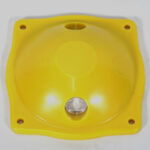You can keep on the right path at night, in heavy rain, or in deep fog by using road studs, which are small yet powerful road lights. They assist in vehicle navigation, boost visibility, and enhance road safety in situations where there is insufficient lighting or when lane lines are difficult to see. Have you ever wondered why certain studs are farther apart from one another while others are closer? That is the main goal of road stud spacing. You should be aware of the street stud classification if you work for a firm that manufactures or sells street studs, in the construction sector, or in the street safety equipment industry. Let us review all you want to know.




What Is Road Stud Spacing?
Road stud spacing describes how far apart road studs are on a road or lane. Proper illumination significantly enhances a driver’s ability to see the road and its boundaries in low-visibility conditions, such as at night or during bad weather. The effectiveness of your security items will be greatly impacted by how you distribute or space them out, regardless of whether you buy them from a street seller or utilize them on the roads.

Road Stud Spacing Guidelines
There is not a single, universal way to one-size-fits-all in road studs. The types of road, the types of road stud, and the particular environment all affect how things turn out.
Standard Spacing Recommendations (by road type):
The first is a widely recognized general rule:
1. Highways and Expressways
- Spacing: 6 to 9 meters
- Reason: There should be six to nine meters between roads and interstates. This is due to the fact that cars require a lot of room in order to drive safely, particularly when they are moving quickly.
2. Urban Roads
- Spacing: 3 to 6 meters
- The width of city roads is increasing by three to six meters. This is due to the fact that in a more complicated environment, objects that are closer together are easier to see when moving more slowly.
3. Intersections and Pedestrian Crossings
- Spacing: 0.5 to 1 meter
- There should be a minimum of 0.5 meters between pedestrians and intersections. This is significant because it increases pedestrian safety and notifies cars of alterations in street usage.
4. General Spacing Range:
Street stud spacing is usually between 3 and 9 meters; however, it can be as low as 0 meters in high-risk regions.
National and International Street Stud Spacing Standards:
UK (Department for Transport)
- The laws governing lane separation on roadways are very clear in many nations. The UK Office for Transport matches various road and walkway types with colored spacers and studs.
US (FHWA / MUTCD guidelines)
- Road type-specific studs are indicated by white dots on the routes and red on the rough terrain. To be visible and appropriate for their environment, raised markers (RPMs) must comply with regulations established by the FHWA, MUTCD, and other states.
Turning bends, fog-prone locations, and dividing roads into regular streets are all covered in the directions. If you intend to sell or install street studs overseas, make sure the exporter’s or manufacturer’s products adhere to international standards.
Factors Affecting Road Stud Spacing
The distance between street studs may change during installation based on a number of actual circumstances. Let us examine the main elements that influence the spacing between road studs and the reasons they are crucial for both product performance and road safety.
1. Road Geometry and Curvature
- Road signal visibility is influenced by the road’s shape and design. Since the driver can see the signals clearly, they can be placed anywhere from 6 to 9 meters apart on straight highways.
- Roads that wind or curve make it more difficult to see objects and reduce the farthest distance you can see. This implies that we occasionally need to make the spaces closer together, perhaps just one or two meters apart, in order to create a continuous track around curves.
2. Vehicle Speed and Traffic Volume
- The rationale is that, especially in low light, drivers must be able to perceive warnings ahead of time in order to react properly when driving at fast speeds. Because cars move more quickly on high-speed roads like highways and drivers must be able to see the markings from a distance, the spacing between markers should be greater (up to 9 meters).
- In slower-moving city roadways, markers should be closer together (between 3 and 6 meters), particularly when traffic stops and starts frequently or where tall buildings obscure the view.
3. Visibility Conditions (fog-prone, night-time use)
Improved visibility measures are necessary in areas that experience fog, rain, snow, or nighttime driving. When driving in foggy or dark weather, drivers can utilize closer lights to see at least one or two signals in front of them. On bright streets, it can be sufficient to spread out a bit more because the lights help make the routes more visible.
4. Weather and Climate
A road stud’s placement and intensity are affected by the weather. Water or mud on the road may make it more difficult to drive carefully in windy or snowy conditions.
- Screws that are heat-resistant or UV-protected might be necessary in tropical areas.
- Use of specialized studs that are suitable for ice and will not be harmed by salt may be required in colder climates.
5. Location-Specific Needs (e.g., tunnels, ramps)
It is crucial because certain routes have certain risks or characteristics that necessitate extra caution.
- Solar studs are necessary, or the fact that they lack common light suggests that they are more dispersed and more intelligent. When slopes rise and fall, roads are more prone to fluctuate. To indicate the proper direction, the studs should be placed closer together.
- Dangerous locations, like those near schools or pedestrian paths, ought to be properly marked (between 0.5 and 1 meter) to warn drivers and slow them down.
Importance of Road Stud Spacing for Different Situations
The studs’ position and purpose are more crucial than their actual distance.
-
Lane Marking Studs
One common approach is to evaluate routes using studs spaced six to nine meters apart. It helps drivers stay in their designated lanes.
-
Edge Line and Centerline Studs
Highways are marked with edge line and centerline studs to indicate their center or edge.
-
Studs in Sharp Curves or Bends
Solar-powered lights with lines could be used to improve road visibility for drivers. A thick set of studs spaced roughly 1.5 meters apart is necessary to help drivers safely negotiate sharp bends or turns.
-
Speed-Reducing or Hazard Zones
Speed-reducing or risk zones are established at intersections and stop lines to encourage vehicles to slow down and be aware of potential hazards, especially when pedestrians are within 0.5 to 1 meter of the area where people are walking.
Why Is Road Stud Spacing Essential for Road Safety?
We provide clients with corner-specific or highly reflective studs for curved spaces, as well as adjustable dividing alternatives. Being a road stud supplier, we offer customized, well-lit or solar-powered road studs that are visible from a distance on congested streets. Time to pick our IP68-rated road studs, such as solar studs, that can withstand a range of weather conditions.
Conclusion
Getting the correct road studs is something you should not overlook, regardless of whether you are a business buyer, construction organizer, or temporary worker. It increases driver safety, lowers accident rates, and ensures that laws are obeyed in accordance with national and international regulations. If you are searching for high-quality road stud manufacturers or a trustworthy supplier of traffic safety equipment, be sure that we are aware of the technical specifications and offer goods that satisfy local as well as international standards.


-80x69.png)

